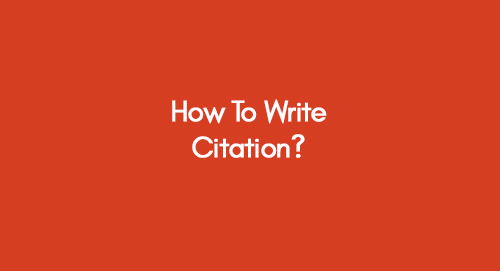
How to Craft an Outline? | A Beginner’s Guide
October 26, 2022
How to Write Recommendations: Do’s and Don’ts.
October 26, 2022Citation is a fundamental aspect of academic writing, playing a pivotal role in upholding academic integrity and building the foundation of knowledge. It serves as a vital link between scholarly works, providing evidence, support, and credibility to the arguments and ideas presented.
Explore New Topics on Dissertation Writings Here
Learn More About Current Research Examples Here
The citation also serves as a means of building upon existing knowledge. By referencing previous studies, theories, or findings, writers contribute to the ongoing scholarly conversation and demonstrate how their work fits into the broader context of the field. This intertextual relationship allows for the development and advancement of knowledge as new ideas emerge from the synthesis of existing research.
The following guidelines will explain how to write citation in an expert way:
Get 3+ Free Custom Topics within 24 hours;
What are Citations or References?
In academic writing, citations or references refer to the process of acknowledging and providing detailed information about the sources used in a research paper or scholarly work. It is a crucial aspect of academic integrity and plays a significant role in building knowledge and supporting arguments with credible evidence.
Explore About Annotated Bibliography Here
Learn Amazing Tips on Dissertation References
By including accurate citations or references, authors demonstrate their ability to engage with existing scholarly literature, establish credibility, and contribute to the broader academic discourse. Proper citation practices also enable readers to locate and access the referenced sources, facilitating further exploration and fostering a deeper understanding of the subject matter.
Types of Citation Styles
1. MLA
MLA (Modern Language Association) is extensively used in the humanities, particularly in English literature, languages, and folklore. This style employs in-text citations and a Works Cited page to provide comprehensive source information. It is also prevalent in disciplines like philosophy, history, and religious studies.
2. APA
APA (American Psychological Association) is widely embraced in the social sciences, including psychology, sociology, and anthropology. It employs in-text citations and a Reference list, enabling clear source attribution and verification.
3. Chicago/Turabian
Chicago/Turabian style finds its place in history and the humanities. This style utilizes footnotes or endnotes within the text and a bibliography at the end of the document to ensure thorough source documentation.
4. Harvard
Harvard style is predominantly utilized in the natural sciences and engineering. It employs an in-text citation system and a reference list, facilitating precise source identification and access. It is also adopted in various disciplines like medicine and dentistry.
5. Vancouver
Vancouver style is extensively employed in the medical and scientific fields. This style incorporates a numbered citation system within the text and a reference list, promoting accurate source attribution. It is commonly used in disciplines such as nursing and dentistry.
6. IEEE
IEEE (Institute of Electrical and Electronics Engineers) style is primarily adopted in engineering, computer science, and electronics. It employs a numbered citation system within the text and a reference list, ensuring precise source referencing. IEEE style also finds applications in disciplines like mathematics and physics.
Explore Amazing Services on Assignment Writing
Learn About Our Most Helpful Literature Review Writing Services
Understanding the distinct citation styles empowers academic writers to adhere to the conventions of their respective fields, accurately attribute sources, and contribute to the credibility and integrity of their scholarly work. Choose the appropriate citation style that aligns with your discipline and project requirements to effectively communicate your research and honour the contributions of other scholars.
Elements to Include
Books, journals, and other forms of information are cited differently in academic writing due to the variations in their formats, publication styles, and available information. Each source type has its unique citation requirements to provide accurate and sufficient information for readers to locate and reference the sources. The following differences on How to write citation will help you understand the different styles:
Journals
- Authors
- Year of publication (in round brackets)
- Article title (in single quotation marks)
- Journal title (in italics, capitalize the first letter of each word except linking words)
- Volume number
- Issue number (if present, in round brackets)
- Page numbers or article reference numbers (When creating your full citation, provide the page numbers for the entire article and the pages you have cited.)
- For online-only articles, use a DOI or website URL.
Books
- Authors or Editors
- Year of publication (in round brackets)
- Title (in italics)
- Edition (if applicable)
- Place Published
- Publisher
- Series and volume number (if applicable)
Websites
- Author (individual or company that developed the webpage)
- Year of publication or most recent update (in round brackets). If there is no date at the bottom of the page, write (no date)
- Page Title (In italics)
- Accessible at: URL (Accessed: date)
Organization's Databases
- Publishing organization
- Year of publication/last updated (in round brackets)
- Title of report (in italics)
- Available at: URL or DOI (Accessed: date)
Newspapers
- Author(s) surname and initials
- Year of publication (in round brackets)
- Title of article (in single quotation marks)
- Title of newspaper (in italics - capitalize the first word of each word in the title except for linking words like and, of, the, and for)
- Edition if required (in round brackets)
- Day and month
- Section and Page reference, if available
Explore More on How to References Thesis in Harvard Style
The variations in citation styles for different sources are necessary to provide clarity, consistency, and adequate information for readers to locate and verify the sources. Following the specific citation requirements for each source type ensures proper attribution and supports the transparency and integrity of academic writing.
Difference Between MLA and APA Formats
The major difference between MLA and APA formats are as followed:
MLA Formatting
MLA (Modern Language Association) is typically used for papers written in the humanities, such as English or History. MLA uses parenthetical citations in the paper's main body, which means that for each source you use, you will include a piece of information in parentheses at the end of the sentence where that source is used. That information will include the author's last name and the page number where you found the information. For example:
- Smith (42) states, "MLA formatting is not as difficult as it seems."
In this sentence, "Smith" is the author's last name, and "42" is the page number where you found the quote. At the end of your paper, you will also include a Works Cited page that lists all the sources you used in your article. The format for each entry on this page will vary depending on the source type, but every listing should include at least the author's last name and the working title.
Here's an example of what an MLA Works Cited page might look like:
- Works Cited
- "Article Title." Website Title. Date Published. URL. Accessed Date Accessed.
- "Another Article Title." Another Website Title. Date Published. URL. Accessed Date Accessed.
- Smith, John. Book Title. City Published: Publisher, Date Published. Print.
APA Formatting
APA (American Psychological Association) is typically used for papers written in social sciences such as Psychology or Sociology. APA also uses parenthetical citations in the body of your paper, which means that for each source you use, you will include a piece of information in parentheses at the end of the sentence where that source is used.
The main difference between APA and MLA formatting is what goes into that piece of information at the end of each sentence. In APA format, that piece of information includes not only the author's last name and page number but also the date when that work was published like this:
- Smith (2020) states, "APA formatting is not as difficult as it seems."
Notice how we included both the author's last name and publication date in our parenthetical citation? That's what distinguishes APA from MLA formatting! Just like MLA formatting, every source used in an APA paper should be listed on a reference page at the end of your paper; however, unlike MLA format, this reference page is titled "References" instead of "Works Cited."
The entries on this reference page will look different depending on the source type, just like MLA formatting. But every listing should include at least the author's last name and year published like this:
- References
- Smith, J.(2020). The article title goes here [Type of Medium]. retrieved from http://www......com/article-title-goes-here/
Conclusion
Learning how to write citations and properly acknowledge your sources can seem daunting at first, but once you get familiar with either MLA or APA formatting--or both!--it'll become second nature! And remember, anytime you use someone else's words or ideas without giving them credit, you're committing plagiarism! So, always cite appropriately to avoid any issues with your teachers or professors.
Get an Immediate Response
Discuss your custom requirements with our writers
Free Online Plagiarism Checker For Students
We will email you the report within 24 hours.
Upload your file for free plagiarism





























